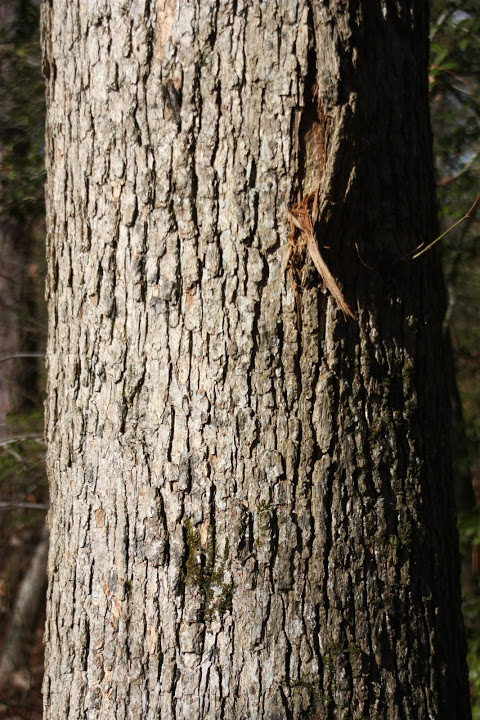Swamp Chestnut Oak
Quercus michauxii Nutt.
Description
Also called basket oak or cow oak, swamp chestnut oak is a deciduous, medium to large tree that normally reaches 40 to 60 feet³ but may attain 100 feet in height ¹. The bark of mature trees is light gray with v-shaped furrows and scaly ridges ². Mature trees may not have branches for the first 50 feet, and the branches extend upward at sharp angles ¹. The alternately attached leaves are up to 9 inches long and 6 inches wide with scalluped margins with 10 to 15 pairs of large, rounded teeth ². The upper surface is green, but the lower surface may be densely hairy with gray hairs ². Both male and female flowers are on the same tree and develop at the time of leaf production ¹. The one-inch acorns mature in one season and will germinate when dropped in the fall ³.

Tree trunk of swamp white oak. @J. Brighton* 2012 , Maryland Biodiversity Project 4

Leaves of swamp white oak. @ J. Brighton 2018, Maryland Biodiversity Project 4
See an image of an acorn of swamp chestnut oak. Cherry Creek Nursery 5
Distribution
Swamp chestnut oak is distributed from southwestern New Jersey, along the Eastern Coastal Plains to northern Florida, west to eastern Texas and north along the Mississippi River drainage to Indiana and Illinois ³. It is scattered in Kentucky and Tennessee ¹. In Maryland swamp chestnut oak is never plentiful but is found more in the eastern part of the states in steam bottomlands 4.

Native distribution of swamp white oak. Wikimedia commons 6
Wildlife Importance
Swamp white oak is considered a tree of high wildlife value ², The acorns are consumed by numerous mammals and birds including white-tailed deer, squirrels, black bear, turkeys, blue jays, and woodpeckers. Numerous moth and butterfly larvae feed on oak leaves including Imperial Moth, Banded Hairstreak, and Horace’s Duskywing ².
Economic Importance
Swamp chestnut oak is lumped with other oaks for use as lumber, flooring, and barrels ¹, Its wood was split and used for making baskets in the Deep South ³.
Threats
Swamp white oak is susceptable to the same threats as other oaks: oak leaf blister, a anthracnose, wood-boring insects, and leaf miners¹.
Interesting Facts
- The Maryland state champion swamp chestnut oak is located in Aberdeen Proving Grounds, Harford County. Last measured in 2010 it stands 120 feet tall and is 102 inches in diameter7.
- The acorns are edible when they fall, which differs from other oaks that need to be soaked or boiled to remove tannins ³.
- Cows eat the acorns leading to its alternative common name ’.
- The scientific name for swamp white oak is from quercus, Latin for oak and from the French naturalist Francois Andre Michaux (1770-1855) who first described the species ³.
References
- USDA Forest Service Silvics, Vol 2, Hardwoods: Quercus michauxii
- North Carolina State Extension: Quercus michauxii
- Missouri Botanical Gardens: Quercus michauxii
- Maryland Biodiversity Project: Basket oak
- Cherry Creek Nursery: Quercus michauxii
- Wikimedia commons: Quercus michauxii
- Maryland Big Trees
* Image used with permission of photographer
Contributed by J. Hull
Towson University Glen Arboretum
